Anting-Anting Collector | Documentary Philippines https://youtu.be/V5tFT6OOu6k … [Read more...]
Vibal launches Anting-Anting book
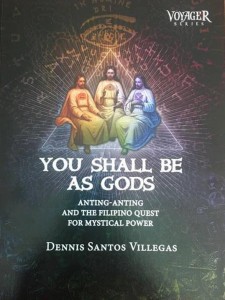
Vibal launches Anting-Anting book September 19th, 2017 http://vibalgroup.com/?p=830 https://shop.vibalgroup.com/products/you-shall-be-as-gods-anting-anting-and-the-filipino-quest-for-mystical-power The anting-anting has always been a curious artifact for both the older and younger generations of Filipino. But what is the anting-anting, how did it come into significance, and what is its role in the Filipino culture? Vibal Foundation attempts to guide the discussion of the anting-anting with the launch of You Shall Be as Gods: Anting-anting and the Filipino Quest for Power during the 38th Manila International Book Fair on September 16, 2017 at SMX Convention Center, Mall of Asia Complex, Pasay City. Penned by author and scholar Dennis Santos Villegas, this thoroughly researched book examines the evolution of the anting-anting throughout history as an essential element of Filipino beliefs from the pre-colonial era. It goes on to discuss the anting-anting’s influence in the Filipino’s struggle against Spanish colonization and even its role in integrating the Judeo-Christian tradition with longstanding indigenous beliefs. The book is the first title in Vibal Foundation’s new series, Voyager, which aims to expose readers into unchartered territories with academic discussions of intriguing topics that often elude formal academic conversations. You Shall Be as Gods: Anting-anting and the Filipino Quest for Power is available at shop.vibalgroup.com. For more information, call 580-7400 or 1-800-1000-VIBAL (84225) or e-mail marketing@vibalgroup.com. Author Dennis Santos Villegas talks about his new book on anting-anting during the launch and book signing event at the MIBF … [Read more...]
BOOK: Anting-Anting Stories And Other Strange Tales of the Filipinos By Sargent Kayme. Boston: Small, Maynard & Company. 1901
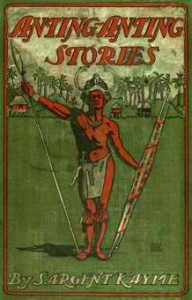
Anting-Anting Stories And Other Strange Tales of the Filipinos By Sargent Kayme Boston: Small, Maynard & Company 1901 [Contents]Copyright, 1901, by Small, Maynard & Company (Incorporated)Entered at Stationers’ HallPress of J. J. Arakelyan Boston, U.S.A.[V] [Contents] Foreword The life of the inhabitants of the far-away Eastern islands in which the people of the United States are now so vitally interested opens to our literature a new field not less fresh and original than that which came to us when Mr. Kipling first published his Indian tales. India had always possessed its wonders and its remarkable types, but they waited long for adequate expression. No less wonderful and varied are the inhabitants and the phenomena of the Philippines, and a new author, showing rare knowledge of the country and its strange peoples, now gives us a collection of simple yet powerful stories which bring them before us with dramatic vividness. Pirates, half naked natives, pearls, man-apes, towering volcanoes about whose summits clouds and unearthly traditions float together, strange animals and birds, and stranger men, pythons, bejuco ropes stained with human blood, feathering palm trees now fanned by soft breezes and now crushed to the ground by tornadoes;—on no mimic stage was ever a more [VI]wonderful scene set for such a company of actors. That the truly remarkable stories written by Sargent Kayme do not exaggerate the realities of this strange life can be easily seen by any one who has read the letters from press correspondents, our soldiers, or the more formal books of travel. Strangest, perhaps, of all these possibilities for fiction is the anting-anting, at once a mysterious power to protect its possessor and the outward symbol of the protection. No more curious fetich can be found in the history of folk-lore. A button, a coin, a bit of paper with unintelligible words scribbled upon it, a bone, a stone, a garment, anything, almost—often a thing of no intrinsic value—its owner has been known to walk up to the muzzle of a loaded musket or rush upon the point of a bayonet with a confidence so sublime as to silence ridicule and to command admiration if not respect. The Editor.[VII] [Contents] Contents The Anting-Anting of Captain Von Tollig1 The Cave in the Side of Coron21 The Conjure Man of Siargao41 Mrs. Hannah Smith, Nurse65 The Fifteenth Wife93 “Our Lady of Pilar”113 A Question of Time131 The Spirit of Mount Apo153 With What Measure Ye Mete179 Told at the Club195 Pearls of Sulu211 [3] [Contents] Anting-Anting Stories The Anting-Anting of Captain Von Tollig There had been a battle between the American forces and the Tagalogs, and the natives had been driven back. The stone church of Santa Maria, around which the engagement had been hottest, and far beyond which the native lines had now been driven, had been turned into a hospital for the wounded Tagalogs left by their comrades on the field. Beneath a broad thatched shed behind the church lay the bodies of the dead, stiff and still under the coverings of cocoanut-fibre cloth thrown hastily over them. The light of a full tropic moon threw the shadow of the roof over them like a soft, brown velvet pall. They were to be buried between day-break and sunrise, that the men who buried them might escape the heat of the day. The American picket lines had been posted a quarter of a mile beyond the church, near which no other guards had been placed. Not long after midnight a surgeon, one of the two [4]men left on duty in the church, happened to look out through a broken window towards the shed, and in the shadow, against the open moonlight-flooded field beyond, saw something moving. Looking close he could make out the slim, brown figure of a native passing swiftly from one covered form to another, and turning back the cocoanut-fibre cloth to look at each dead man’s face. Calling the man who was working with him the surgeon pointed out the man beneath the shed to him. “That fellow has no business there,” he said, “He has slipped through the lines in some way. He may be a spy, but even if he is not, he is here for no good. We must capture him.” “All right,” was the answer. “You go around the church one way, and I will come the other.” When the surgeon, outside the hospital, reached a place where he could see the shed again, the Tagalog had ceased his search. He had found the body he was looking for, and sunk down on his knees beside it was [5]searching for something in the clothing which covered the dead man’s breast. A moment later he had seen the men stealing towards him from the church, had cleared the open space beneath the shed at a leap, and was off in the moonlight, running towards the outposts. The surgeons swore; and one fired a shot after him from his revolver. “Might as well shoot at the shadow of that palm tree,” the one who had shot said. “Anyway it will wake up the pickets, and … [Read more...]
And you shall be as gods: The culture of the anting-anting (Part 2) By Dennis Villegas
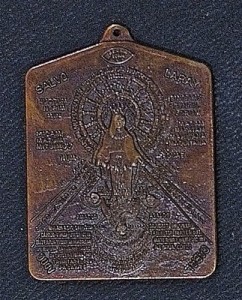
And you shall be as gods: The culture of the anting-anting (Part 2) By Dennis Villegas Monday, 09 August 2010 The Philippine Online Chronicles (www.thepoc.net) http://thepoc.net/thepoc-features/buhay-pinoy/buhay-pinoy-features/9267-the-culture-of-the-anting-anting-and-you-shall-be-as-gods-part-2-.html The arrival of the Spaniards in the Philippines in the 16th century proselytized the Filipino’s concept of God. To easily conquer the archipelago and introduce the Roman Catholic religion without antagonizing the superstitious and religious beliefs of the Filipinos, the Spanish friar missionaries presented the God of Roman Catholicism to be the same ancient Filipino God Bathala. The synthesis of the Roman Catholic religion and the pre-colonial religious and superstitious beliefs of the early Filipinos created a new kind of religion called Folk Catholicism, the religion of many millenarian groups in Southern Luzon, as well as the religion of anting-anting believers. The Trespicio medallion of the Infinito Dios and the Tres Personas The trinitarian dogma which is the most important of all Catholic doctrines gave way to the mythology that God, a spirit being, is an eye contained in a triangle. The triangle (or in anting-anting parlance, trespico), is the perfect representation of God, as it contained three equal sides or three equal corners, consistent with God’s three equal personalities. The triangular medallion, therefore, becomes one of the most popular of all the anting-anting. It symbolizes the oneness of the Infinito Dios and the Santissima Trinidad. Those who keep and faithfully believe in the trespico anting-anting can achieve oneness with the Infinito Dios and the Santissima Trinidad. The Trespico medallion, believed by anting-anting faithful as an effective protector against evil because it contains the image and names of God. The symbols in this medallion include the Eye, representing the Infinito Dios, and the initials A.A.A which are the initials of the names of the Santissima Trinidad: Avetillo, Avetemit, Avelator (other names of the Santissima Trinidad are Aram, Ardam, Adradam). The ROMA is the initial of the title and name of God which means Rex Omnipotentem Macmamitam Adonay. One of the Trespico Seals of the Revolutionary Government of General Emilio Agunaldo in 1899. The Trespico as seen in the altar of the religious sect Tres Personas Solo Dios in Mount Banahaw by the author in 2010. God's Plan of Salvation God’s plan for the world is to save it from the clutches of the Devil. For this reason, one of the Santissima Trinidad has been assigned to go down to earth to save humankind. Only through his sacrifice and death can humankind be saved. But since God is immortal and cannot die, he must assume a human form, and before he must be born a human, he should be conceived by a woman. God being born as a human by a human mother is again one of those concepts that cannot easily be understood, especially among the early Filipinos who have a simple pre-colonial belief in the existence of God who is the first being in the universe. But for God to become human, and for God to be born by a woman, is something complex, especially if Catholicism teaches that the woman is the Mother of God, instead of just a blessed human person assigned by God to bear his human form. The woman--the Virgin Mary--conceived God in her womb. The official Catholic doctrine on her personality is stated clearly in the official Catholic book Catechism of the Roman Catholic Church published by the Vatican: Mary is truly “Mother of God” since she is the mother of the eternal Son of God made man, who is God himself. The image of a Mother God therefore plays an important role in the theogony of the anting- anting. In Filipino society, the mother of the family is viewed as the “ilaw ng tahanan” who provides her children with proper care, upbringing and education. Moreover, the early Filipino society, although strongly patriarchal, viewed women as mediators to God. As proof, the early priests were women called babaylan. The veneration of the Virgin Mary as the Mother of God is therefore consistent with the Filipino view of the important role played by the mother in Filipino family and society. The babaylan priesthood still exists at present in many folk Catholic religions in Southern Tagalog, most especially in the Ciudad Mistica de Dios and the Tres Personas Solo Dios in Mount Banahaw, where the religious leaders and priests are women. The idea of a Mother God was accepted by the early Filipinos as a given. Thus the Virgin Mary eventually took her place as an important God in the pantheon of the Gods among Filipinos. Monotheistic though the Catholic religion is as claimed by the Vatican, to the simplistic views of the pre-colonial Filipinos, the Infinito … [Read more...]
And you shall be as gods: The culture of the anting-anting (Part 1) By Dennis Villegas
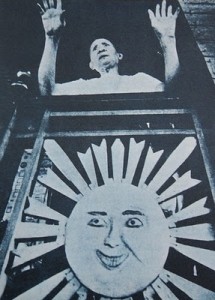
And you shall be as gods: The culture of the anting-anting (Part 1) By Dennis Villegas The Philippine Online Chronicles (www.thepoc.net) http://thepoc.net/thepoc-features/buhay-pinoy/buhay-pinoy-features/9131.html Deep in the night of May 20, 1967, around 400 curiously-attired men congregated on Taft Avenue in Manila, near what is now Vito Cruz, with the intent to march to Malacanang Palace to ask for President Marcos’ resignation. The men wore anting-anting and colorful vests with mixed Latin and Tagalog inscriptions on them. Seemingly at odds with their appearance, they were also wielding daggers and three-foot-long jungle bolos signifying their rebellious intent. They were part of the millenarian sect called Lapiang Malaya (Freedom Society), a quasi-religious political society led by the charismatic 86-year-old Supremo Valentin delos Santos, a former Catholic priest, trained auto mechanic, one-time circus performer, and failed candidate in the past three presidential elections at that time.Early in May 1967, Tatang Valentin, as the Supremo was called, had demanded that Ferdinand Marcos step down. He also wanted the Philippine Armed Forces to surrender their arms to him. Deeply disillusioned by what he termed as the oppression of the poor and the continuing evil influence of foreigners in the Philippines, Tatang Valentin decided it was time to establish a new government, with him as the new Supreme Commander, Commander-in-Chief, and President of the Republic of the Philippines. President Marcos promptly rejected Tatang Valentin’s demand. As the kapatid ("brothers," as Lapiang Malaya members were called) started to arrive from the provinces to gather in the society’s compound in Pasay, the Philippine Constabulary cordoned off the area to prevent more members from joining the already frenzied group. Then at around 12:30 in the morning of May 21, as the tension between the Lapiang Malaya members and the constabulary heightened, mock gunfire rang in the air, allegedly shot by a prankster. A violent skirmish between the kapatid and the constabulary followed – one that was so one-sided it was later to be called a massacre. As the constabulary opened fire, 32 of the kapatid were killed and some 40 seriously wounded. The constabulary had one mortality: a soldier who was hacked to death. In addition, five constabulary soldiers were wounded by bolo hacks, and three civilians hit by stray bullets. One of the kapatid killed in the Lapiang Malaya massacre of May 21, 1967. Note the sacred vest and scarf he wears that gave no protection against bullets. Purist anting-anting believers would later say that those killed lacked faith in their anting- anting. This massacre of the Lapiang Malaya was one of the bloodiest episodes in recent Philippine history. As the front-line members of the Lapiang Malaya fell to gunfire, many other members realized their anting-anting would not protect them. Dispersing in many directions, they were later arrested and charged with rebellion. Later that morning, Tatang Valentin surrendered to the constabulary. He was brought to the National Mental Hospital, together with 11 of his high-ranking lieutenants. All of them were subjected to psychiatric evaluation and pronounced lunatic. Following his diagnosis, Tatang Valentin was confined to a cell together with a violent patient, who allegedly mauled the old man into a coma. He never regained consciousness and was declared dead in August 1967. The official medical report stated he died of pneumonia. After Tatang Valentin’s death, the Lapiang Malaya was officially dissolved by the government, with most members either pardoned or sent back to their respective provinces. Most of these were peasants, laborers, and common folks from Southern Tagalog who believed in Tatang Valentin’s promise of a new government based on “true equality and true liberty.” They also subscribed to Tatang Valentin’s promise of supernatural powers once they wore their anting-anting and sacred vests. He convinced them that the bullets of the enemies would turn into snakes and fall around them. But as it happened, and as proven in the bloody morning of May 21, the amulets they wore were no match for the automatic gunfire of the constabulary. The bullets easily tore through their vests, flesh, and bones. Tatang Valentin delos Santos surrenders to the Constabulary In retrospect, the Lapiang Malaya massacre is just one of the many episodes in the history of the Filipino mass movements whose combined quest for freedom and faith in the anting-anting led them to fight the oppression of those in power. The revolt of the Cofradia de San Jose in 1840, the Katipunan in 1896, the Colorum rebellions of Southern Tagalog in 1897, the Philippine Revolution of 1899, the Makario Sakay and Felipe Salvador rebellions during the early years of the … [Read more...]
Anting Anting by Reynaldo S. Galang
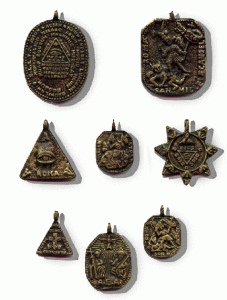
Anting Anting Shrouded in secrecy and mystery, the anting-anting is a subject close to the Filipino’s heart. It holds promise of invincibility, of victory and of heroic deeds. Legends have been born and men have died because of the lure of the mysterious and powerful anting-anting. The anting-anting made a resurgence into popularity in the early 70’s when the film Nardong Putik chronicling the life of the outlaw Leonardo Manecio made its debut. The hero of the film, a local Robin Hood, credited his ability to survive and escape numerous ambushes and gunfights to his anting-anting. There is much dispute as to what his anting-anting really was. Some claim it was a smooth pebble of rare and mysterious material that Nardong Putik kept under his tongue. While others say it is a 66-day old fetus that he kept in a small crystal container. Whatever his anting-anting was, Nardong Putik’s ability to elude the law and his enemies made him a legend and a hero to many people. Jikiri, the noted Muslim pirate, eluded the Philippine Constabulary and U. S. soldiers for over three years. Yet Jikiri boldly operated in broad daylight. The legendary source of his galing (gift) — an anting-anting, of course. These stories and more contribute to the growing number of legends and belief in the efficacy of the anting-anting. Combined with the equally mysterious Orascion (a special verse or prayer), warriors can be psyched to become confident and daring to undertake suicidal missions. There are many prescribed ways of acquiring an anting-anting. The easiest is to have an existing, sacred anting-anting bestowed to you as an inheritance or reward. This happens very rarely, for the agimat (amulet) is usually buried with its owner and master for continued protection against spirits from the nether world. Stealing an anting-anting makes it lose its power and is therefore a useless alternative. An anting-anting loses its power when it leaves its master’s possession without his knowledge or blessing. Various types of anting-anting can be bought at holy places but these are patay (dead/blanks) with no power whatsoever. These blanks have to undergo sacred and secret rituals to become empowered and effective. There are many different methods to make an anting-anting sagrado (sacred). The most popular day for the anting-anting to have birtud (power) is on Good Friday. This, according to legend, is when God abandons His creation and the spirits roam freely and can be lured, captured, harnessed and enslaved by the brave and mighty. Another popular occasion is at midnight during a full moon with the ritual taking place at a cross road or a cemetery with a sacrificial black cat as a bait or offering. Another kind of anting-anting, known as Mutya, comes from plants, such as a banana or a palm tree. This requires a lot of patience and diligence for one has to wait until the heart of the banana discharges its essence, a crystal clear solid drop that must not be allowed to touch the ground and must be swallowed immediately. With this captive prize, legends say that a successful and prosperous life is guaranteed. Some types of anting-anting or orascion are meant as love charms. Most are for protection — against the forces of darkness, against one’s enemies, and even against sickness. Others are for special gifts, such as the mysterious and esoteric art of Hilot (massage and healing), Hula (fortune telling) and Kulam (spells and witchcraft). However, every anting-anting and every orascion carries with it an immutable commitment. One must be prepared to perform the required rituals, the mandated daily devotion, the annual pilgrimage, to keep the birtud of the anting-anting. Man will always be fascinated with this mysterious harbinger of success, victory and protection. Many, though not all, of the Philippine Grand Masters and Masters of martial arts believe in the power and protection of the anting-anting and orascion. And everyone of these believers, without exception, recognize the value and worth of diligence, dedication and discipline in martial arts training. Like the anting-anting, the easiest way to learn a martial art is to find a good teacher, a worthy master. Someone who, like the anting-anting’s master, will pass on to you, the secret and power of his own knowledge and skills. Again, like the anting-anting, this knowledge and skill must be nurtured with diligent practice, with moral righteousness, discipline, devotion and dedication. Written by Reynaldo S. Galang Copyright © 1994, 1997 Bakbakan International … [Read more...]
















